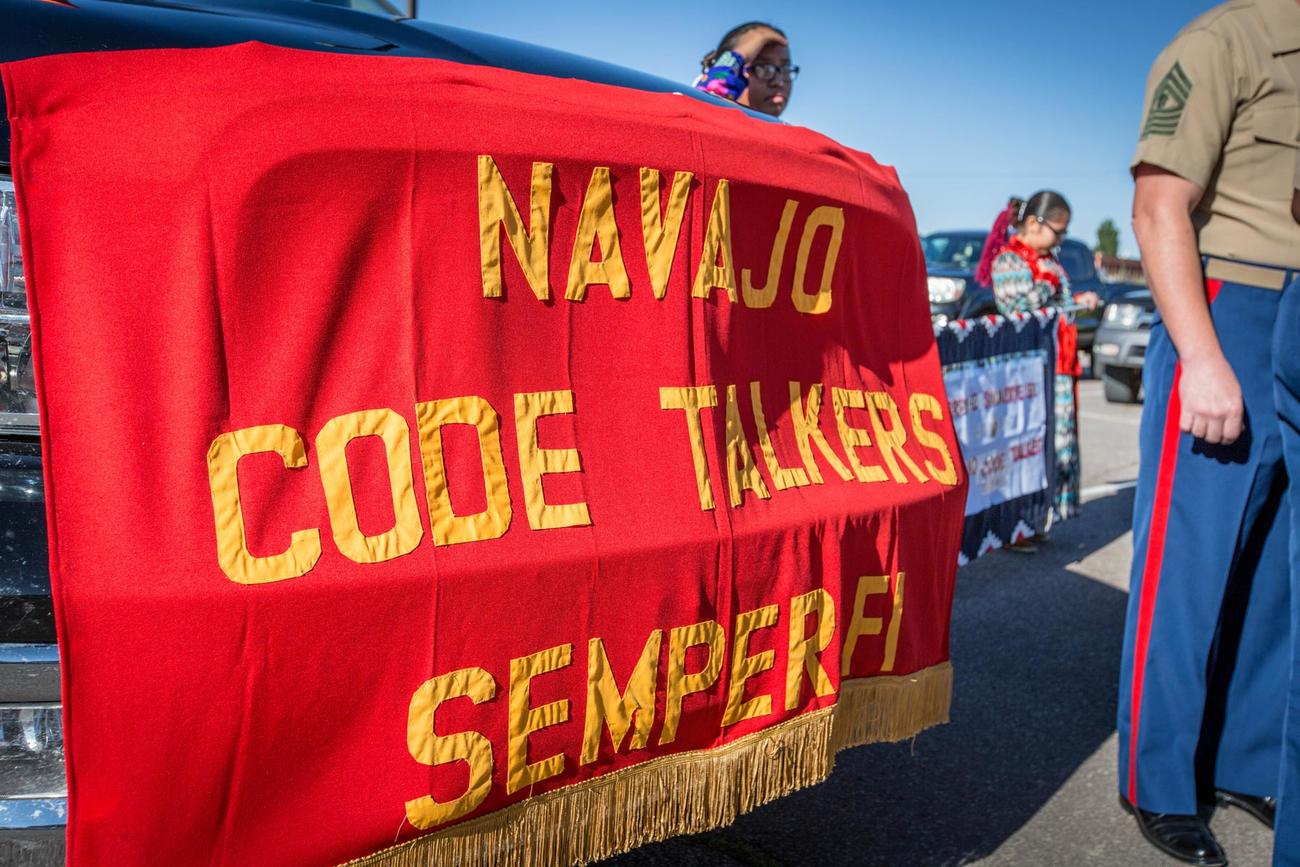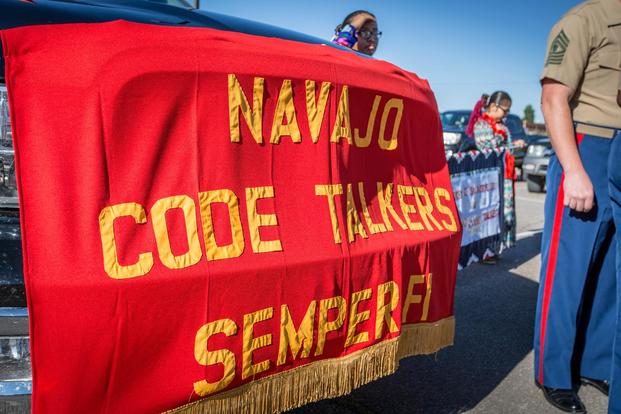

On paper, the project looks promising — a 54,000-square foot museum honoring the legacy of some of New Mexico’s most valiant soldiers.
They were the Navajo Code Talkers, U.S. Marines who conveyed military orders, maneuvers and plans in their own language, confounding the Japanese during World War II and helping American forces achieve victory in the Pacific.
Their efforts helped turn the tide of the war, the late Roy Hawthorne, a Navajo Marine veteran who served as a Code Talker on various South Pacific islands, told The New Mexican in 2013.
“When the Navajos arrived with their code, it was a whole new ball game,” he recalled, noting how their contributions changed the shape of the war — and tribal soldiers’ sense of themselves. “The face of the Navajo changed: Instead of us losing, we were winning.”
But creating a place to remember the Code Talkers — almost all have died in the 70-plus years since the war’s conclusion — on a patch of ground in McKinley County near the Arizona border still requires tens of millions for completion, and proponents worry bureaucratic and turf issues could keep the facility from becoming a reality.
Though late state Sen. John Pinto, a Code Talker from Gallup, secured more than $1 million in executive and legislative capital outlay funds to get the museum started in 2019, the remaining $46 million needed to make it a reality has not been appropriated by either state, federal Navajo Nation or private sources, the entities most likely to fund it.
At a meeting last week of the Legislature’s Indian Affairs Committee, some lawmakers expressed worries — and frustration — about a loss in momentum and uncertainty about who will ramrod the museum to reality.
“The question I have is where is the funding coming from? Whose project is it?” said Rep. Patty Lundstrom, D- Gallup, who sits on the Indian Affairs Committee.
Lundstrom, chairwoman of the influential House Appropriations and Finance Committee, said after Monday’s hearing the museum is an “absolutely important project from my perspective. People often forget how important the Navajo Code Talkers were to winning World War II.”
But she and other members of the committee said they think it’s more appropriate to seek federal funding for the project since the museum would, in its own way, serve as a memorial to the Code Talkers and thus be akin to a federal monument to U.S. military history.
Rep. Anthony Allison, D- Fruitland, said “the significance of the Navajo Code Talkers is very exceptional, so therefore it should be treated with the same respect as given to the Lincoln Memorial … [and] national landmarks.” He said he has brought up the issue of federal funding with several of the state’s congressional delegates.
Rep. D. Wonda Johnson, D- Crownpoint, said the Legislature could be part of a multi-body financial source — along with the feds and the Navajo Nation — for the project.
However, Johnson also cautioned: “As state legislators, we can give so much, but I don’t think we can commit to $45 million. So a combined resource from different entities and initiatives would be my recommendation.”
Regan Hawthorne, the son of the late Roy Hawthorne who also sits on the board of the nonprofit Navajo Code Talkers Museum, Inc., wants to keep the organization as autonomous as possible. Toward that end, he said his board will be seeking private and corporate funding to start the initial construction phase for the museum come spring.
“We will probably not approach any one governmental entity to construct the museum,” he said.
Hawthorne added he believes his organization will have to raise at least $50 million, but perhaps just $5 million by the spring to get the project going. He said he sees the museum as being in the 35,000-square-foot range.
“We are looking for major donors; we are looking for the bulk of the startup money that includes development on the site,” he said.
Board members of the museum, including descendants of the Code Talkers, are committed to making that happen, Hawthorne said, but he said while some board members want to seek federal or local funding, “the conflicting message there is we would like to remain separate of any governmental influence and control.”
Louis Grachos, executive director of SITE Santa Fe, an art museum in Santa Fe, said a privately driven approach can work when it comes to raising money for a capital campaign.
“It’s actually wise for them to give it a shot because, in my history, I have found most major capital projects begin with a handful of individuals with passion who really want to make it happen,” he said.
The key, Grachos added, is to articulate a clear, long-term vision of what the museum can be, then find “one or two individuals who have a really deep belief in the vision and will certainly have the input in terms of helping shape a campaign.”
Once that’s done, he said, museum officials can look for matching capital funds from other donors — and, if need be, state and federal entities.
Initial plans paid for with money the state appropriated in 2019 include five separate galleries ranging from 3,000 to 5,000 square feet. They would focus on Navajo culture and history, the years leading up to World War II, the start of the Code Talkers program, the use of the code in combat and the legacy of the 400 Marines who served in those units.
Derek Meier, senior project manager for Wilson & Company, the Albuquerque engineering firm that did the preliminary planning study on the museum, said it remains a challenge to pin down an actual cost for the project “and with inflation it’s probably going to get higher.”
He said at this time his company is not under contract to do any further work on the project. He said museum leaders “have to work that out still as to who will carry forward the design.”
That was another concern lawmakers have about the project — who’s running it? Legislators said there is confusion over who should actually take control of the museum.
Sen. George Muñoz, D- Gallup, said it’s tough to tell who’s in charge — the state, the Navajo Nation or the museum group.
“I know there’s way too many hands in the kitty over there,” he said.
Though Paulson Chaco, chief of staff of the Navajo Nation, took part in last week’s presentation to the Legislature, he did not respond to a phone call and email seeking comment. Johnson said Chaco made it clear he “was going to go back to the Navajo Nation and request support” for the museum.
She said there remains “some confusion about physical agents … who is really at the helm of this.”
Pinto, a Democrat and one of the longest-serving legislators in New Mexico history, had long wanted to build a Navajo Code Talkers Museum and Visitors Center. He died in May 2019, just months after securing the initial investment in his dream project.
Most of the Code Talkers hailed from the Four Corners region that encompasses the Navajo Nation. Their accomplishments were heralded because, before the Navajos’ arrival, the Japanese had proved adept at breaking all American codes regarding troop movements in the South Pacific.
As Roy Hawthorne said in 2013, the Japanese would often intercept American radio transmissions to say, “Thank you very much for the information. We will be waiting for you.” And they would be waiting, he added.
But as the Diné language was unwritten — and few non-Navajos knew it — code strategists decided to create a 200-plus-word code using Diné words and translated by trained Navajo Marines. The Japanese were baffled — as was anyone else listening in. Navajos not versed in the code didn’t know what was going on either, Roy Hawthorne said.
Regan Hawthorne insisted the project is moving forward and has land to build on near Tse Bonito, plus access to water. He said his museum group is working on putting together a more specific proposal and cost estimate to send to potential donors “whether they be private or governmental.”
He said he believes there is a broad group of potential donors who will contribute to highlighting the legacy of the men who used their language to help defeat the Japanese.
“This Indigenous language … brought such a superior code-breaking force to their knees,” he said. “Consider all of that, together with national pride, and people whose parents and grandparents served this country in World War II who are now in a position to help finance something that brings attention to this kind of legacy.”
___
(c)2022 The Santa Fe New Mexican (Santa Fe, N.M.)
Visit The Santa Fe New Mexican (Santa Fe, N.M.) at www.santafenewmexican.com
Distributed by Tribune Content Agency, LLC.
© Copyright 2022 The Santa Fe New Mexican. All rights reserved. This material may not be published, broadcast, rewritten or redistributed.
